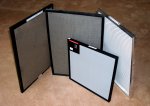Search engine visitors - click here to access entire "$ensible Home" web site
Click here to see a descriptive illustration showing several types of new central air cleaners.
Dear Jim: Although we use a room air cleaner, my family still has allergies (sneezing, headaches, read eyes, etc.). We are considering installing a central air cleaner. What is the most effective design to buy? - Judy T.

A: A combination of room air cleaners and a central furnace/air-conditioner mounted air cleaner is a good defense against allergies. Poor indoor air quality, which is often more polluted than outdoor air, can also cause colds, other infections and aggravate health problems such as asthma.
The effectiveness of various air cleaners varies with the type of particle (allergen) you need to remove from the air. Mold spores, dust mite feces and pollen are relatively large airborne particles. Smoke, bacteria and viruses are very small particles and are more difficult to remove.
Another consideration is the resistance the air cleaner creates in the duct system. A dense filter may be effective, but it can cause excessive air flow resistance making your furnace/air conditioner operate inefficiently.
To avoid this problem, several designs of by-pass HEPA air cleaners are available with their own blowers. HEPA filter media is often used in hospital operating rooms. These are attached to the main return duct. They draw air out of the duct, clean it and blow it back into the duct again.
If you have a very airtight house that gets stuffy, select a HEPA model that introduces filtered fresh outdoor air into your duct system. For extremely hot or cold climates, choose one with a heat recovery unit.
The most common types of inline (uses furnace blower) air cleaners are electronic, self-charging electrostatic and pleated media. Electronic air cleaners use very little electricity. They create a high voltage charge that causes the tiny particles in the air to stick to its washable cells.
It is important to regularly clean the filter cells to maintain their high efficiency. They are generally small enough to fit into your dishwasher. Electronic filters are particularly effective for the smallest particles.
Washable self-charging electrostatic air cleaners slip into the existing filter slot. The air blowing over the plastic materials creates a static charge. These are very effective for larger particles. The charged particles stick to the filter media and can be rinsed off in the bathtub.
Pleated media filters are thick filters that trap the particles. The best ones require duct modifications for installation. To purify air in addition to cleaning it, install an ultraviolet (UV) light purifier in the return duct. The UV light kills virus, bacteria, mold spores, and other germs.
Instant Download Update Bulletin No. 950 - buyer's guide of 11 whole-house air cleaner maufacturers (35 models) listing filtration methods (self-charging electrostatic, pleated media, HEPA, electronic, UV purifying), dust arrestance ratings, features, prices, an allergen/design selector chart and illustrations and descriptions of selected models.
Dear Jim: I am remodeling my garage into a study. I plan to insulate the walls with foam installation and cover it with paneling. I heard I should include a layer of drywall first. Is it really necessary? - John E.
A: From strictly structural and energy efficiency standpoints, installing drywall beneath the paneling is not necessary. Some high-quality wood paneling is strong enough to span the furring strips.
Fire safety is the primary reason drywall is required. This is particularly true with rigid foam insulation that can burn quickly. The drywall acts as a fire break to stop or slow the spread of a wall fire.